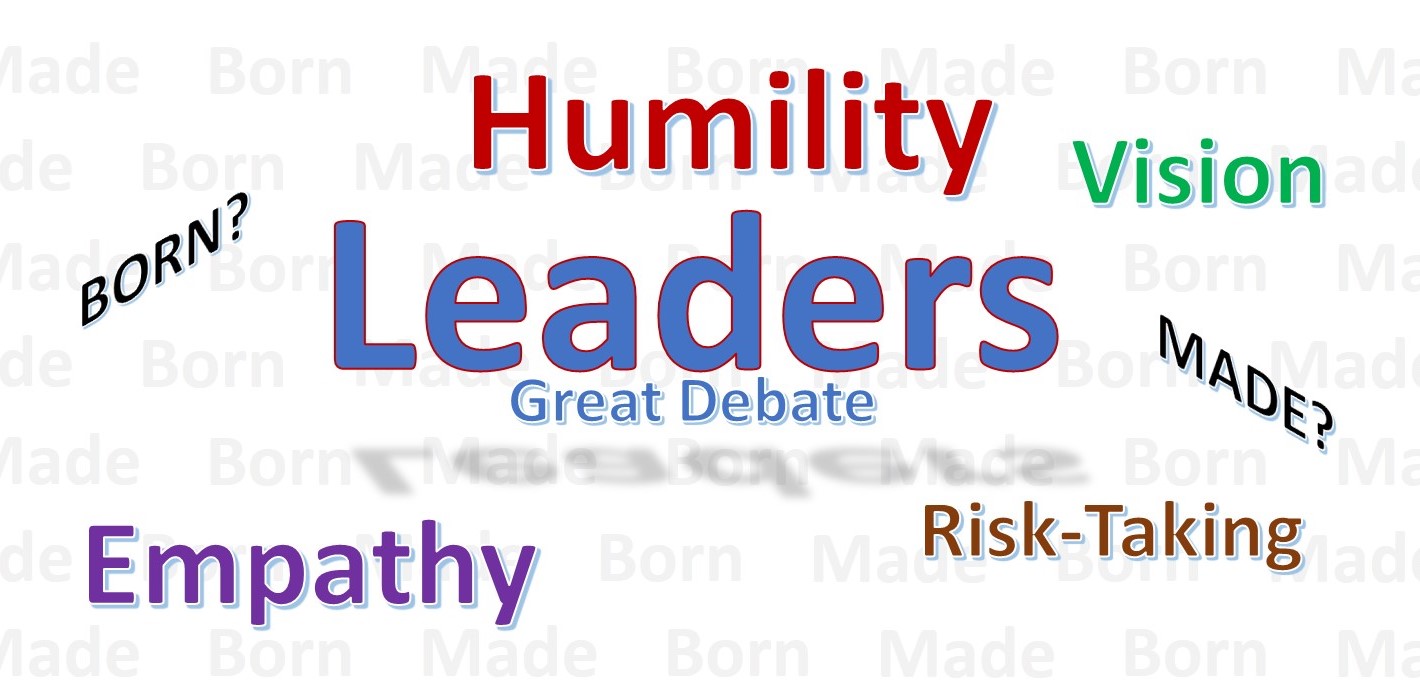The Great Leadership Debate
Category : Healthcare General Leadership
The great debate about leadership is whether leaders are born or made. The correct answer is “Yes”. Some people have certain innate qualities that gives them a high potential for leadership (born). They can still become better leaders though through additional training. On the other hand, others without all of the innate qualities can become better leaders through training (made). Keep in mind that not everyone will be a good leader which is logical because society couldn’t exist if everyone was a leader.
Based on extensive research, interviews with many executives and much personal self-reflection, we have identified those innate leadership qualities as:
- Humility – putting the needs of others ahead of their own
- Empathy – knowing how to get things done through people
- Vision – the ability to see things others don’t see or before others see them
- Risk-Taking – comfort with being out front and charting new territory
Humility is the recognition of one’s own importance or standing. It is the self-awareness that you are no better than the person next to you or across from you. Sometimes known as modesty, humble people make everyone feel special. Humility is the quality that is most natural. It can be learned to a certain degree, but authentic humility is hard to duplicate.
Leaders exhibit humility by making themselves available to the people they work with. Their time is valuable, but it is not so valuable that they can’t take the time to listen or discuss something that is important with others. It is very easy for people to identify leaders with authentic humility. They are the ones who return phone calls, respond to e-mails and engage with others not as a leader-to-subordinate, but as a person-to-person.
Dr. Toby Cosgrove, President and CEO at the Cleveland Clinic, is a firm believer in the need for humility in healthcare leaders. He considers humility, “the ultimate wisdom.” Leaders don’t know it all and should be aware of their own limitations. It “is not the absence of self-worth, but the validation of self-worth.”
Empathy is the ability to mentally identify with the feelings, thoughts or attitudes of others. It is not the same as sympathy which implies feeling sorry for someone. It involves knowing people and knowing about the people you work with, especially your direct reports. On a business level, this includes understanding their motivations, career goals, education, etc. On a personal level, it includes knowing their entertainment interests, marital status, children’s ages, etc. This information can be used to help establish a sincere relationship with the person which makes the decision to go over and above what is needed easier to accept.
Empathy is not just for direct reports but should also be included with relationships with indirect reports and peers. Some executives like to ‘walk the floors’ and listen to people to get to know them especially when they start a new position. This quality can be learned somewhat especially by adding notes to a contacts file, but that only provides a ‘robotic’ approach to empathy. Sincere empathy comes from the heart and is easily distinguishable from insincerity.
Leaders exhibit empathy by getting to know and understand the people they work with. They have to generally like people and like working with people to be the most effective. It is also a considered one of the requirements for effective leadership by Dr. Cosgrove.
Vision is being able to see things others don’t see or before others can see it. People with vision can sometimes see the endgame before it even begins. The challenge for such visionaries is getting others to see the vision to gain their buy-in. This process can be very frustrating for people with this natural quality because the people they work with, especially in healthcare, are so used to doing things a certain way and can be reluctant to make any changes. This is a quality that can be learned to a degree using decision making processes and tools, but those with natural vision can reach the same or better direction more efficiently with a better understanding of the most important variable – the human factor.
Leaders with vision can effectively chart the course for where they need to go and communicate that vision in a manner that everyone can understand. Good leaders chart the course by providing direction. Great leaders make their followers feel good about where they are going.
Risk-Taking is built in to becoming a leader. By accepting the position, the leader has fundamentally accepted a certain amount of risk. The leader needs to be prepared to accept the good as well the bad outcomes that may occur. There are several types of risks the leader must be prepared for including: reputation risk, career risk, interpersonal risk and financial risk. Being at the front of the team or organization opens the leader to the “arrows” potentially pointed at their back. If the leader can’t accept criticism or negative feedback, maybe they should consider another position.
Leaders who take risk aren’t just taking risks for risk’s sake. The risk is calculated and weighed against the potential for success or failure. They have to be ready to try new things when necessary and adapt their leadership style to the situation. Calculating risk is a skill that can be learned, but the nature of leadership requires the leader to accept a certain level of risk with the position.
The Mixology
The next questions most people want to ask is how many traits do they need to have and how much of each trait has to be innate versus learned. At this time, there is no mathematical formula to unequivocally answer these questions, but, just like leadership, you sometimes just have to have a ‘feel’ for it.
Based on interviews, observations and research, the best leaders are the ones that possess, and are good at all four traits. Some possess three traits while others only two. Even though they may not be gifted with all four traits, they may have other compensatory abilities that make up for what they are missing.
Although the best leaders have most of these traits innately, there is always room for more learning, but it in most cases, it has to be less than 40%. A person can learn some of the qualities, but there is only so far they can go with humility or empathy that is not authentic.
Excerpted from the book, Prescribing Leadership in Healthcare. The book is based on the proprietary 5-step Professional Leadership Process™ which creates a personalized leadership development program built on an individual’s innate qualities and strengths. It is designed as a continually improving process to help leaders at any level of the organization develop and adapt a personalized leadership vision and philosophy for utilization in their daily leadership routine. The program creates better leaders by incorporating the most often overlooked steps that research indicates are essential to better leadership development. Additionally, the book includes the leadership perspectives from interviews with top healthcare executives such as Dr. Toby Cosgrove(President & CEO, Cleveland Clinic), Dr. Laura Forese (EVP & COO, New York-Presbyterian), Dr. Michael Hunt (President & CEO, St. Vincent’s Health Partners), Nancy Schlichting (Retired CEO, Henry Ford Health Systems) and others. Includes a Foreword written by Chris Van Gorder, President & CEO of Scripps Health.
-
←→

Prescribing Leadership in Healthcare - SIGNED COPY & Free Shipping
$14.95 - $19.95Now, more than ever, we need leaders in healthcare who are well-versed in all aspects of leadership. Unfortunately, the skills that made healthcare leaders successful in the past may not be enough to be successful in the future. Managing change requires a very special set of skills and abilities.
"Prescribing Leadership in Healthcare" is based on the proprietary 5-step Professional Leadership Process which is a personalized, leadership development program based on an individual’s innate qualities and strengths. It is designed as a continually improving process to help leaders develop and adapt a personalized leadership vision and philosophy for utilization in their daily leadership routine. It creates better leaders by incorporating the most often overlooked steps that research indicates are essential to better leadership development. Additionally, it includes the leadership perspectives from several healthcare executives, business executives and sports champions.
Order today and receive your copy signed by Professor Bennett!- Buy 3 at $16.95
- Buy 7 at $14.95
Maximum quantity exceededMinimum purchase amount of 0 is requiredPrescribing Leadership in Healthcare - SIGNED COPY & Free Shipping
$14.95 - $19.95Successfully Added to your Shopping CartAdding to Cart...



